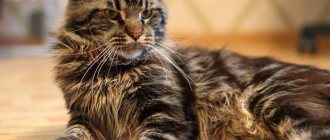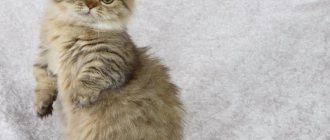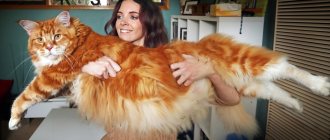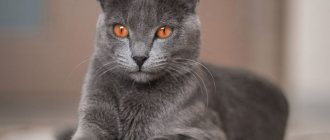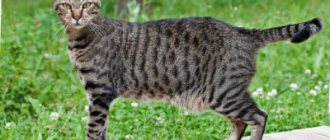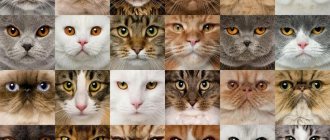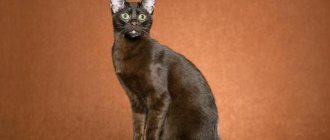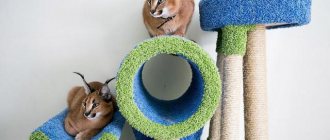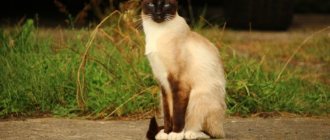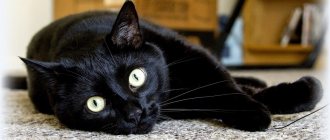American Curl
This breed of cats with round ears is now at the peak of popularity; besides, the pets themselves have not only an unusual appearance, but also a friendly disposition, they are very sociable, devoted to their owner, and play with pleasure. Distinctive features of the appearance of these animals are as follows :
- Elegant graceful physique.
- Flexible long tail (its length matches the size of the body).
- The average weight is small - 5-7 kg (males), 4-5 kg (females).
- The coat can be either long or short, with long-haired Curls being the most popular among breeders.
But the most striking detail of the pets’ appearance is their rounded, curved ears, the unusual shape of which is explained by a mutation of the hard ear cartilage. In the photo you can see that the inclination of the shell is individual for each cat, it can be 180°, or it can have a more modest value - 90°. A characteristic feature of the breed is that the round tip should not exceed 1/3 of the ear. One of the difficulties faced by pet owners is the fragility of the ear cartilage, so you need to be very careful with your pet.
Maine Coon
This breed is a semi-long-haired cat. The breed was bred in the USA, and is one of the largest purebred representatives in the world, created to live next to humans. This is a large breed of cat, with an extraordinary appearance, a variety of colors and an affectionate character.
The Maine Coon first appeared in Northeast America, in the state of Maine, about a hundred years ago. Part of the animal's name is associated with this area. The second component of the name in translation means raccoon or lynx, which is explained by the similarity of the fur coat with the coat of a raccoon. And with the presence of tassels, cats resemble a lynx.
The breed developed in northern climates, which explains the appearance of wide bones and long hair between the pads on the paws. Size does not match weight. Males weigh more than 10 kg. This breed of tasseled cats entered the Guinness Book of Records thanks to an amazing specimen weighing 16 kg.
Character
The Maine Coon is distinguished by its character and interesting features:
This ear-tufted cat adores her family and doesn't require much attention herself. They do not like loneliness; if you have to leave her alone for a while, you need to purchase various toys for the cat so that she does not get bored before the owners arrive. They love water and water procedures very much. There should always be a bowl of water next to the food for your pet to splash into. Maine Coon is able to communicate using different sounds. In addition to meowing, they make sounds similar to squeaks and trills. They have developed body language. If a cat wants to express a special reverent attitude, it hits its head. The breed is adapted to living in any climatic conditions. They can withstand winter cold and snowy weather without problems. Very friendly. The color of cats of this breed with tufted ears varies in 75 different color combinations. The breed includes both ginger cats and individuals with a chocolate color; lilac-colored specimens are possible, although these variations are recognized as a deviation from the standard and are not the norm for this species.
Maine is a coon with a half-meter tail, long hair, wide strong paws, powerful muscles and a large head. The cat's head is elongated, high cheekbones, triangular ears with tufts. The eyes of Maine Coon cats are oval-shaped, the color should be in harmony with the coat.
Care
Caring for this breed is easy:
- The coat needs to be brushed daily; Provide her with a scratching post;
- For food and water you need to place separate bowls, preferably made of glass or stainless steel;
- It has a tendency to develop periodontal disease; to prevent the disease, you need to regularly brush your pet’s teeth.
- The animal should be provided with its own corner, as it needs privacy from time to time. When the cat is in its corner, you should not touch it, so it will feel safe.
- It is recommended to feed the Maine Coon dry food, which will keep the teeth in good condition.
You can add to your diet:
- Raw beef;
- Cottage cheese;
- Quail eggs;
- Boiled chicken.
The Maine Coon is a breed of cat with tassels, included in the list of the most expensive species in the world ($4,000 to $80,000).
Siberian cat
Classics of the genre. Warm fur coat and bushy tail, massive build. It is worth noting the teeth: they are incredibly strong. If a cat wants to bite, he will really bite and it will hurt a lot.
There are tufts between the toes, indicating a wild forest origin. Development is slow, the cat develops only by 5 years. The front legs are shorter than the hind legs, which gives them agility and grace.
The special charm of the muzzle is given by slanted eyes, long eyebrows and mustaches, often curled like a spring.
An excellent option for people prone to allergies. The fact is that the saliva of a Siberian contains a minimum of allergen.
You especially need to take care of your eyes, they often fester. The coat is brushed 3 times a week.
A little selfish. They play when they want, they will not tolerate violence against the cat’s personality. Avid lovers of heights: every shelf will be examined, even the closet will not remain untouched. And they step softly, without dropping anything.
They hunt well, catching both mice and rats. They treat strangers poorly and defend their territory. According to a typical Siberian, the best place to rest is near the battery, with the paws spread and the tail extended.
Price: from 5000 rubles.
Do you want to know about other cats, such as caracals with tufted ears?
Watch the video:
https://youtube.com/watch?v=_VBgdHblChA%3F
Scottish Fold
Another cat with round ears is called the Scottish Fold. This is a very cheerful and friendly animal that does not require special care. The characteristics of the breed are :
- Medium-sized body with thick, pleasant-to-touch, plush-like fur.
- The head has a rounded muzzle and round whisker pads.
- The wide-set ears have an unusual shape - their upper part is bent so that it hides the pinna.
- Round big eyes. We allow them to have different colors, but they must match the color of their coat.
- The nose is wide.
- The tail is medium in size, tapering towards the end.
The round shape of the ears is the result of a genetic mutation in the simplest domestic cat. Animals with good care can live up to 15 years, but owners should remember two weak points of the breed. These are diseases of the joints (the tail is especially dangerous) and the heart. Cats are also prone to overeating.
Ukrainian Levkoy
Representatives of the breed have rounder ears than the Scots. In the photographs you can see that their appearance is very unusual: they have large round ears and a complete absence of hair.
To develop the breed, Don Sphynxes, Scottish Folds, Orientals, Peterbalds and domestic cats were used. Due to such a rich list of ancestors, the Ukrainian Levkoy got its original appearance. The name of the breed was given by the gillyflower, which is distinguished by its external resemblance to the downward curved small round ears of such cats. The animal's traits are :
- Muscular body of medium size. Weight – about 5 kg.
- The eyes are large, almond-shaped. Preferred colors are blue, green.
- The skin is covered with numerous folds and is always hot.
- Ears with rounded tips are set high.
They are distinguished by a pliable disposition, sociable, intelligent and quick-witted, devoted to their owner and very affectionate.
Highlander
A new breed, the Highlander, also has round ears. These are very unusual animals of an exotic species, which also have the name “mountain lynx”. However, among the ancestors of these cats there were no dangerous predators; their ears are slightly curved back, and their muzzle in its expression resembles a trot. The distinctive features of the breed are:
- Powerful muscular body.
- Short tail.
- The eyes are large and round in shape.
- The acceptable colors are varied, the standard recognizes the presence of 1-2 colors, as well as color point colors.
Cats with round ears are diverse, among them there are long-haired and short-haired, large, medium and small in size, but they all look bright, unusual and attractive.
Source
Cat with round ears: Breed
Some time ago, photos of cats with rounded ears appeared on the Internet, which are very similar to cartoon mouse ears. These pictures simply blew up the Internet, users wanted to know what this new exotic breed was.
But, to the disappointment of many, it turned out that these cats are just a high-quality photoshop, and in fact such a breed does not exist.
There are only cats with more or less rounded ears. These include:
- Persian cats.
- Exotics (similar to Persians, but larger eyes).
- American Curls. Their ears bend back and look round.
To enlarge the picture, click on it
Cat breed with round ears: Wild houses
In addition to true domestic cats, hybrids of domestic and wild cats: servals and savannahs have rounded ears. These exotic representatives are no longer so rarely seen in cities as pets.
We must understand that their character and needs are closer to those of their ancient ancestors , who bloodthirstyly dealt with their victims. That's why cats and predators.
It is also worth considering that it is not recommended to keep such pets in a one-room apartment.
They need a separate corner or even a room. In addition to the high price for such rare cats, the peculiarity is that they need more food than an ordinary domestic cat.
Cat breeds
Each breed of animal is determined by specific features in appearance and character traits that are unique to it - this is called the breed standard, which must be recognized by various organizations of felinologists (TICA, FIFe, WCF, CFA, IFA, ICU, WACC, etc.) for each of them own rules of recognition. All purebred cats are given pedigrees.
One of the most amazing and mysterious breeds is the Maine Coon - a gentle giant with a serious look. These creatures are called “indoor lynxes,” which is not surprising, because... they are one of the largest domestic cats.
All over the world this breed is called “Scottish Fold”, but we are more accustomed to calling these cute cats “Scottish Fold”. Their “cute” appearance will not leave anyone indifferent - you immediately want to pick up such a creature and cuddle it.
Millions of people around the world cannot imagine their existence without such “plush” bundles of happiness. These aristocratic, friendly, charismatic and very clean pets have long been one of the most popular cat breeds on the planet.
Bengal cats are incredibly beautiful animals that combine the spectacular appearance of wild predators and the docile nature of pets. Well, the main “feature” of these creatures is their “leopard color,” which is why they are called “domestic leopards.”
Siamese - graceful oriental beauties and beauties (who managed to preserve their roots almost in their original form) stand out for their special grace, temperamental character and a certain diminutiveness.
Among the many breeds, there is one endowed with incredible elegance and grace - this is the Abyssinian cat - an intelligent, flexible and dexterous creature. There is a certain mystery and special sophistication in her, and her appearance is called “divine.”
This breed is distinguished by its special silver-blue color and piercing green eyes. Russian blue cats are “real noblewomen.” These are graceful and mysterious creatures, delighting their owners with a playful but obedient disposition.
Siberian cats are considered real Russian beauties for their expressive eyes, chic “fur coat” and friendly character. They have long won the hearts of many cat lovers... a very long time ago - the first mentions of them are found in the 16th century.
The Oriental cat, at first glance, is impressive with its ears (in comparison with the body and head, they seem simply huge). This is a wonderful friend and you cannot betray him (the cat will not understand if you give it to another person).
Charming “Siberians” with a “Siamese” color, a chic hypoallergenic “fur coat” and an easy-going disposition are the pride of Russian felinologists from the banks of the Neva... Dmitry Medvedev got himself a kitten of this particular breed, and Vladimir Putin gave one to the Prime Minister of Japan.
Source
How to find out a cat's breed by coat color
Very often it is possible to distinguish a purebred aristocratic cat from a simple Murka by color. Domestic cats are usually very plainly colored, two or three colors, and have large spots or stripes.
Experts have worked thoroughly on the colors of purebred animals. Sometimes you can immediately determine the specific breed of a kitten using this feature.
Siamese
The striking Siamese color, the so-called color point, is characterized by darker areas on the cat's face, ears, paws and tail.
Initially, only Thai or Siamese cats could boast of this, but over time, breeders gave this coloring to many breeds:
- Balinese;
- British;
- Neva Masquerade;
- Himalayan;
- Burmese;
- Persian;
- ragdoll, etc.
Cat with Siamese color - Balinese
Himalayan cat with Siamese color
There are several varieties of point colors in cats, depending on the contrast of colors and the smoothness of the transition from dark to light:
- seal point - soft cream;
- blue point - silver-blue;
- chocolate point - brown-chocolate;
- lilac point - pinkish-bluish;
- red point - pronounced apricot (red);
- cream point - delicate beige-amber;
- caramel point - grayish-beige;
- cinnamon point - red-brown;
- fawn point - pale cream.
Chocolate point cat
Only a specialist felinologist can competently determine all the nuances of point colors. A kitten is always born white. The marks (points) begin to darken after a few days.
Blue
Solid blue color, also known as grey, is traditionally considered an integral feature of British breed cats. It can be detected immediately even in a newborn kitten. But in fact, all shades of grayish blue are also found in many other purebred representatives of the cat world, such as:
- chartreuse;
- Maine Coon;
- Russian blue;
- Scottish;
- oriental;
- Nibelung;
- korat etc.
Breed: Russian Blue cat
Sand
If the kitten has a rare sand or red color (sorrel), then this allows us to determine whether it corresponds to one of the breeds:
- Somali;
- Abyssinian
A cat with a sorrel coat color is an Abyssinian breed
Wild
Natural animal colors, making cats smaller copies of tigers and leopards, are called wild (tabby) and are found in the following breeds:
- savannah;
- ocicat;
- Serengeti;
- Bengali;
- Egyptian Mau;
- caraquet;
- Kanaani;
- Kurilian bobtail;
- safari, etc.
Kurilian Bobtail - wild-colored cat
Most often, wild colors are characteristic of hybrid breeds. You can instantly determine who belongs to them.
Brown
The uniform and monochromatic brown color of a kitten's fur coat will immediately determine its royal origin and worthy position in the cat elite. This color is practically never found in the wild.
Cats of the following breeds come in similar colors:
- British;
- oriental (havana brown);
- Burmese;
- Scottish;
- Abyssinian;
- Persian;
- Chantilly-Tiffany, etc.
Burmese - a cat with a brown color
Breed of cats with round ears
We are used to seeing in our lives only cats with triangular ears, which have small tassels at the tips, and they do not stand out so much from the whole body. But there are some types of ears that cats have that are breathtaking, and many people wonder about this incomprehensible appearance. There is a special breed of cats with round ears. You may be surprised to meet such a cat, because the appearance of such animals is not the same as we are used to seeing. Such cats are very rare, but they do exist. These cats are representatives of a group of genetic mutants who at birth acquired this interesting feature - round ears. It is very interesting to find out how this happened and what breeds exist.
Features of care
When caring for big-eared cats, you must first take into account the characteristics of the breed to which they belong. But proper ear care is extremely important for all “mouse cats” - after all, the larger the ears, the more problems can arise with them.
Each breed has its own maintenance nuances, but ear care is the same for all cats.
Ear hygiene
Cleanliness, as they say, is the key to health. Timely and high-quality hygiene of cat ears is the prevention of infection, and, consequently, various serious diseases. Check your pet's ears regularly and contact your veterinarian immediately if the following symptoms appear:
- redness and itching;
- swelling;
- unpleasant odor;
- painful sensations.
If you have any problems with your ears, contact your veterinarian.
For preventive care at home, you should choose a ready-made product for this purpose - the choice of ear drops is quite large. The use of alcohol, peroxide and other homemade products can lead to irritation and even burn the delicate surface of the ear.
Contamination and the occurrence of inflammatory processes can be caused by hairs growing too densely inside the ear - they must be removed, but only very carefully so as not to cause pain and discomfort to the animal.
The cat's ear should be clean and free of excess hairs.
Before proceeding directly to the procedure of cleaning the ears, it is recommended to do a light massage - lightly rub and knead the ears for five to ten seconds. Then give the cat a couple of minutes to shake its head - this will cause the softened wax to come out of the ear canals. Wipe it with cotton pads or swabs soaked in ear cleaning fluid, but be sure to use different swabs for your ears. Try not to go deep into the ear canal.
Ear cleaning is a regular and responsible process.
Video: “pockets” on a cat’s ears
Why does a cat have big ears?
Ears mean a lot and people don't even realize how interesting and wonderful a tool they are for cats. If you look at these cats, you might be surprised how big their ears are. Interestingly, there is a special application on the Internet that creates a breed of cats with mouse ears. Such cats automatically become like mice.
First of all, ears are hearing, and cats have very good hearing. Why are cats given such hearing? It all starts with the fact that their auricle is very unique in structure. Each shell has 32 muscles that are very mobile. Thanks to these muscles, cats' ears turn into unique locators. Cats can hear any sound source, no matter how far away.
An interesting information is given that a person can catch a sound in the range of 18 kilohertz, while a cat can catch a sound in the range of 60 kilohertz. Imagine how powerful this is.
Also, thanks to their ears, cats can remember sounds and information that a person tells them. It’s not for nothing that they say that cats understand everything. Pets with large and round ears quickly recognize the voice of their owner.
Features of caring for cats with a flattened face
Cats with a flattened muzzle are not found in nature (with the exception of the Pallas cat, which to some extent became the progenitor of most modern breeds of brachycephalic cats).
Due to mutations at the gene level, carriers of cute flattened faces often experience breathing problems. Because of this, both a small kitten and an adult cat with a brachycephalic skull structure often snore in their sleep and slurp while eating (the animal is simply uncomfortable breathing). However, the manifestation of the first painful symptoms usually begins at an advanced age for the cat.
In addition, breeders of such breeds note that cats with flattened faces suffer more often and more severely from colds and allergies; with the slightest cold, the cat will experience problems with nasal discharge. Therefore, we need to take better care of their health.
The specific structure of the muzzle also dictates its own nutritional rules for brachycephals: for example, purebred cats with a flattened muzzle are usually extremely capricious in their menu. They prefer premium food or natural poultry and fish. In summer, you can give animals fresh vegetation. It is not recommended to feed such cats regular homemade food - it contains many spices that are harmful and even dangerous for your pet. In addition, due to mutations, brachycephals have very sensitive digestion.
Excessive lacrimation is another “scourge” of poor animals. Due to the short shape of the muzzle, the eyes of cats are set closer than dictated by the needs of nature - because of this, the functioning of the lacrimal glands is disrupted. When a cat has a cold, their eyes can often become inflamed and fester.
The specific structure of the skull imposes many responsibilities on the owners of such cats. All breeds of cats with a flattened face require careful care in various respects.
Cats with a flattened face should be protected from drafts and temperature changes.
Thus, the general rules for caring for brachycephalic cats are as follows:
- Feeding with premium food (both wet and dry).
- Daily eye cleaning (with a cotton pad soaked in tea leaves or chamomile decoction).
- Regular cleaning of the ears (with a cotton swab).
- Trimming nails if the animal has a habit of tearing up upholstered furniture.
- Regular examination by a veterinarian (with age, cats with flattened faces find it harder to breathe).
- Keeping exclusively at home without drafts and trips to nature.
With a large selection of cat breeds with a flattened face, you need to understand that any breed is the result of a random gene mutation or the work of breeders. Beautiful and affectionate cats with brachycephaly need special care and attention. Therefore, when choosing a pet, you should take this fact into account.
If the owner is not ready to pay attention to his pet, then it is better to choose an ordinary cat
Flat-faced cats were artificially bred and separated into separate breeds, of which there are not many in the world.
Persians are the most popular among them, although other representatives cannot be ignored, from exotic and Himalayan cats bred from Persians with their long hair to proud British or fold-eared Scottish Folds. And each of them has a characteristic feature - the brachycephalic shape of the muzzle, giving the pet a doll-like expression. But it is worth noting that such animals require special care.
But it is worth noting that such animals require special care.
Domestic cat breeds with big ears
It's time to consider what breeds with round ears exist in our time. All cats are different, but such ears do not have a bad effect on the animal’s life and only help and delight the pet. Take a look at photographs of such cats and carefully examine the types of cats with ears like mice.
Balinese or Balinese cat
This cat is descended from the Siamese, but their fur is slightly long and very fluffy. Balinese has subtle and graceful body curves. The body itself is elongated and the legs are long. Weight does not exceed 5 kg. These cats:
- They are active and love to stick their little nose in everywhere.
- Very loyal to one owner.
- Loves children and loves to talk.
- Hates being alone and needs to play together.
- Willful, characteristic.
Abyssinian cat
The cat is named after ancient Ethiopia - Abyssinia. It has mainly 4 colors: wild, blue, sorrel and fawn. The muzzle of such cats is elongated, the ears are set wide apart and have an elongated shape.
- Restless.
- They are very friendly not only to people, but also to other pets.
- They don't like loneliness.
- They always remain loyal to their owner.
- Curious.
- They love heights and constantly like to be in higher places.
- They don't like to sit on their laps.
- Good memory.
Oriental cat
Looking at this cat, many are frightened by its appearance and character. Such cats have simply huge ears compared to such a small triangular muzzle. They look more like aliens, which is why many people don’t pay much attention to such cats. They were bred from the Siamese. The coat is short, without undercoat. The eyes are big. The body is athletic, agile and refined.
- The cold is a wild hell for them.
- Very smart, easy to learn tricks and commands.
- They are patient, but they always remember the bad.
- They are highly devoted to their owner, so separation will be an unbearable event.
Somalia
A distant relative of the Abyssinian cat. So the character and appearance will be very similar. Long-haired. They have a very fluffy tail. Flexible body, hind legs longer than the front. The eyes are large, green or yellow. Adult cats weigh no more than 5 kg. Most often, the fur is red in color.
- Very affectionate and devoted.
- Active, curious.
- They love to climb everywhere, especially in closets.
- They love children, so they will form unusually strong friendships with them.
- Jealous of other felines.
- Hyperactive, restless in one place.
Devon Rex
Owners of short and curly hair. The eyes are huge and set very low on the sides of the muzzle. Spout with a break. More like elves. The body is muscular and stocky. Most often, such cats hold their tail in a ring. The maximum weight of an adult cat is 4.5 kg.
- Affectionate and devoted.
- Balance between calm and play.
- They love children.
- They love to sit next to their owner, especially on their laps.
- They are afraid of loneliness.
- Smart and curious.
- The voice can only be heard in rare cases.
- They love comfort.
Canadian Sphynx
It was this breed that was bred first. I don’t have fur, so their coat has velvety skin and a lot of folds. The head is very large compared to the body. The ears are very elongated, the eyes are wide.
- They love everyone and everything: adults, children, other animals.
- They are constantly with people and need warmth and affection.
- They love to travel and are not stressed about moving.
- Smart.
- They are so faithful that if they feel the owner’s sadness, they run to support him.
Elves
This breed is very rare and belongs to an expensive price category. They are also classified as hairless. The ears are expressive and set very wide apart. The eyes are almond-shaped and often have color, like the body. Nose with a bend in the bridge of the nose. The tail has the shape of a whip - very powerful, the tip is pointed. There are many colors, the most common are white, chocolate, red and blue.
- Highly intelligent cats.
- They are curious, but they will think about doing something.
- They cannot stand loneliness and are loyal to their owner.
- It takes a very long time to get used to a person, but once you get used to it, it’s forever.
- Affectionate and friendly.
- Other animals also require some getting used to, but they can make friends.
- Energetic and active at a young age.
- They are touchy and love to talk to their owner.
Siamese cats
They have a triangular face shape, separated by a wide nasal septum. The eyes are bright blue. The ears are wide, slightly slanting. The color has many shades.
- Noisy and restless.
- They become attached to their owner and love to talk to him.
- Rushes to defend its owner.
- Holders of high self-esteem.
- They are touchy and can sometimes take revenge if they are greatly upset.
- They do not tolerate high-pitched voices, shouting, or punishment.
Breed description, standards, appearance
Georgian cats have an original appearance, thanks to which they cannot be confused with representatives of other breeds. These are graceful, slender, flexible animals with very large ears and expressive green eyes.
Dimensions and weight
Georgians are medium-sized cats. The height at the withers of an adult male reaches 32–33 cm, females are slightly lower – about 30 cm. The average weight of the animal is 4–5 kg.
Anatomical characteristics
There are strict requirements for the appearance of a Georgian cat. According to the WCF standard, it should look like this:
- A medium-sized wedge-shaped head with a slightly elongated muzzle and well-defined cheekbones.
- The frontal part smoothly transitions to the bridge of the nose.
- The Georgian cat has a narrow chin.
- The nose is quite wide and straight with a large nose.
- The slanted eyes are almond-shaped, with slightly raised outer corners.
- The iris is colored emerald, and in white cats it is blue.
- The huge ears have a wide base and rounded tips.
- The physique is thin, but the muscles are clearly visible.
- The thin neck smoothly transitions into a strong chest.
- The stomach is flat, the back is straight, the back of the body is slightly raised.
- The Georgian cat has thin, slender legs, and rounded paws.
- The long tail has approximately the same thickness along its entire length and a pointed end, it resembles a whip.
Color and coat type
Georgian cats come in short-haired and long-haired varieties. The first variety is more common. The cover is quite thick, but soft to the touch and shiny like silk. There is no undercoat.
Georgian cats have many colors. They can be plain or with a pattern. The most popular solid colors:
- black;
- white;
- chocolate;
- cream;
- lilac;
- red;
- blue;
- cinnamon;
- faun.
Depending on the type of pattern on the coat, the colors are smoky, darkened, tortoiseshell, bicolor and tabby. The last group includes:
- marble;
- spotted;
- brindle;
- ticked;
- silver.
Possible breed defects
Georgian cats with the following serious defects in appearance are not allowed to participate in exhibitions and championships:
- extra toes;
- kinks on the tail;
- presence of undercoat;
- color not meeting the standard;
- not green color of the iris (unless we are talking about white cats);
- signs of cryptorchidism.
Members of the commission reduce marks if the Georgian cat has insufficiently large ears, slanted eyes, a full body, or an insufficiently developed muscular corset. Cats that have white medallions on their fur will not become champions either.
Wild pets
There are a couple of breeds that are derived from wild relatives, but can still live comfortably within four walls.
Serval has the largest ears of all cats. A medium cat, the size reaches a height of up to 65 cm. It can weigh up to 20 kg. Bright and orange colors with black spots. The body is athletic, graceful and has attractive curves.
- They are distrustful of people because of their savagery.
- They easily get along with ordinary domestic cats.
- Not everyone can have such a cat at home.
- It is necessary to start her at home from a very early age, taking her away from the female.
Savannah - the height of this species reaches 60 cm, weighing up to 15 kg. Large and very strong. The color is also spotted.
- Very smart and resourceful.
- Energetic.
- The habits are more like those of a dog.
- They hate the cold.
- They love to walk and swim.
- They adore their owner.
The sand cat is smaller in size than a domestic cat, with an approximate body length of up to 90 cm. The fur is thick and soft, sandy or gray in color. The ears are widely spaced and very huge.
The most expensive cat breeds. Top 18 (with photos)
17th place: Peterbald or St. Petersburg Sphynx is a breed of graceful cats, bred in Russia in 1994 as a result of an experimental crossing of an Oriental cat and a Don Sphynx. The Peterbald's body can be completely hairless or covered with soft down. These elegant animals have a slender body, a long head shape and large ears set apart to the sides. St. Petersburg Sphynxes can be described as curious, friendly and affectionate cats who vitally need communication with people. Thanks to their exceptional intelligence and extraordinary communication skills, they are highly trainable. The cost of a Peterbald depends on its class and gender and can vary from 300 to 1300 US dollars .
16th place:
The Himalayan cat is a breed of long-haired cats, identical in appearance to the Persian, with the exception of blue eyes and color point color (light body with a dark muzzle, paws, ears and tail), obtained by crossing the Siamese breed with the Persian. The breed originated in the 1950s. in USA. Himalayan cats represent the golden mean between the Persian and the Siamese: they are not as intrusive as the Siamese, and are slightly more active than the Persians. Himalayans are very affectionate, playful, obedient, friendly animals with a calm and gentle character. The price of a Himalayan cat is 500-1300 USD .
15th place: The Scottish Fold or Scottish Fold is a very interesting breed of cat, the main distinguishing feature of which is the characteristic structure of the ears, curved forward and down. This unusual detail of their appearance is a consequence of a gene mutation. The first representative of this breed was discovered in 1961 in Scotland. Scottish Folds have a balanced disposition, are playful, intelligent, and get along well with all family members. In addition, they have a number of amazing features. Firstly, the specific voice of a cat, which differs from ordinary purring in its creaky quality. Secondly, they can stand on their hind legs, looking at what interests them. And thirdly, Scottish Folds like to sit in an L-shaped position with a straight back and outstretched legs - this position is appropriately called the “Buddha pose”. The cost of cats of this breed ranges from 200-1500 dollars .
14th place: The Canadian Sphynx is a breed of hairless cats whose history officially began in 1966 in Canada, but there is evidence that these unusual creatures were known back in the days of the Egyptian pharaohs and were common in the temples of the Aztecs and Incas in ancient Mexico. Sphinxes are famous for their unusually sociable, peaceful and friendly nature. They are very graceful, energetic, intelligent and endlessly loyal animals to their owner. Very often they can be caught doing a curious activity: they can freeze for a long time in bizarre poses, looking at something or simply lost in thought. The price of a thinking cat of the Sphynx breed varies from 400 to 1500 dollars .
13th place: British Shorthair is a medium to large sized cat breed that received official recognition in 1984. Their colors come in a wide variety, but the most popular are solid colors (lilac, blue, black, chocolate). These short-haired cats have a truly English character, the main qualities of which are self-esteem and restraint. British women are particularly independent - they calmly endure loneliness, extremely rarely fawn on their master and do not require much attention at all, but when they have a desire to play or communicate, they will certainly let you know about it. The cost of a British aristocrat can range from 500 to 1500 conventional units .
12th place: Maine Coon is a large breed of domestic cat, whose ancestors lived on farms in Maine (Northeast America). Due to their original black striped color and huge fluffy tail, they looked like raccoons - hence the second part of the name “coon”, that is, “raccoon”. Representatives of this breed can weigh from 5 to 15 kg, and the body length of an adult Maine Coon can reach 1.23 m. Despite their slightly menacing appearance, they are known as “gentle giants”. Maine Coons are flexible, affectionate, friendly and playful creatures that are famous for their “singing ability” and often delight their owners with unique solo performances. The price of a vocal cat ranges from 600-1500 dollars .
11th place: LaPerm is a breed of cat with curly hair that appeared in the United States in the 1980s as a result of free crossing. The breed received official recognition in 1996. Laperms are inquisitive, affectionate, active and love to hunt. In addition, they are hypoallergenic and are perfect for families whose members suffer from allergies. The price for kittens of this breed ranges from 200-2000 dollars , depending on their gender and class.
10th place: Russian Blue is one of the most popular breeds of short-haired cats, originating from the cats of the ancient Slavs. This breed became known outside Russia in 1893, when the English breeder Karen Cox brought two blue kittens from Arkhangelsk. The main distinguishing feature of the breed is its short blue coat with a beautiful silver tint. Russian Blues are kind, obedient, peace-loving cats, but can sometimes be stubborn and freedom-loving. Legend has it that they bring prosperity and happiness to the house. You can buy a talisman in the form of a Russian blue cat for 400-2000 dollars . The Russian Blue is one of the top 20 most popular cat breeds in the world.
9th place: Serengeti is a breed of domestic cat, bred in 1994 in California as a result of crossing Bengal and Oriental cats. It received its name in honor of the habitat of the serval - the Serengeti Nature Reserve, Tanzania. The average weight of the Serengeti is 8-12 kg. They have a strong build, large ears, spotted coloration and very long legs. They can be described as graceful, agile, playful, sociable and peaceful animals. The cost of representatives of this breed is 600-2000 conventional units .
8th place: Elf is a young cat breed, the first representatives of which were bred in the USA in 2006. American Curls and Canadian Sphynxes took part in the breeding work, resulting in an unusual breed of hairless cats with forward-curved ears. Elves are very friendly, intelligent, mischievous, sociable, inquisitive and loyal creatures. Those wishing to purchase such a unique pet will have to pay a considerable amount - 2000 US dollars .
7th place: Toyger - a large breed of cat, resembling tigers in its appearance, was bred in the USA in 1993, and received official recognition in 2007. The breed's creator says the toy tiger breed was developed to inspire people to care about the conservation of tigers in the wild. Despite the name, toygers are not very toy-sized: the average weight of an adult is 7-10 kg. The Toyger has a calm temperament, is intelligent and easy to train. The cost of a mini-tiger varies between 500-3000 dollars .
6th place: The American Curl is a breed of short-haired and semi-long-haired cats, first found in California in 1981. She became famous for her unusual ears, which are folded back like little horns. Interestingly, American Curl kittens are born with straight ears, and they begin to curl back between the 2nd and 10th days of life. Cats of this breed are very intelligent, curious, friendly and playful, adapt well to new conditions and are incredibly loyal to their owner. The price of an American Curl kitten can range from $1,000 to $3,000. Such a high price is also due to the fact that the American Curl is one of the rarest cat breeds.
5th place: The Bengal cat is a hybrid breed developed in the 1980s in the USA as a result of crossing an Asian leopard cat with a domestic cat. Its main advantage is its luxurious thick leopard-print fur. The weight of an adult Bengal is 4-8 kg. Representatives of this breed are very sociable and need constant human company. They are smart, active and, despite their roots, not at all aggressive, but on the contrary, very gentle and sensitive animals that quickly adapt to a new environment. Bengal cats have several characteristic habits: despite their impressive size, they often climb onto their owner's shoulders. In addition, they love water treatments - they often play with water, and sometimes persistently ask to take a shower with their owner. The price of a Bengal cat varies from 1000 to 4000 conventional units , depending on its class and gender.
4th place: Safari is a rare hybrid cat breed that arose as a result of crossing an ordinary domestic cat and the South American wild cat Geoffroy. The first representatives of the breed were bred in the early 1970s in the USA to study leukemia. Adults weigh on average 11 kg. This unusual animal combines the luxurious coloring of the Geoffroy wild cat and the gentle essence of the domestic cat. They have a friendly and balanced disposition, are incredibly intelligent and energetic. There is information that the Safari is the kindest and most loving of all existing hybrid breeds. The cost of cats of this breed ranges from 4-8 thousand conventional units .
3rd place: Khao Mani is a cat breed of Thai origin that has an ancient pedigree dating back several centuries. The earliest mention of them is in the Tamra Maew, or Cat Book of Poems (1350-1767). In ancient Siam, kao-mani lived only in royal families, and was considered a symbol of good luck, longevity and wealth. The main distinguishing feature of this cat is its snow-white, smooth fur and expressive eyes, which can be yellow, blue or multi-colored. Kao-manis have a reputation for being sociable, intelligent, active and easy to train cats. The price for a kitten of this breed can vary from 7,000 to 10,000 dollars .
2nd place: Chausie is one of the rarest breeds of domestic cats, which was bred by crossing a domestic Abyssinian cat and a wild African cat (swamp lynx). The first representative of this breed was bred in the USA in the late 60s. The average weight of adults ranges from 4 to 8 kg. Chausies are slender, graceful short-haired cats with long legs and large ears. They can be characterized as intelligent and active animals that do not lose their enthusiasm throughout their lives. Due to their sociable nature, they really do not like loneliness and prefer any company, be it a person, a cat or even a dog. The cost of Chausie kittens of the highest class is 8-10 thousand conventional units .
1st place: Savannah is the most expensive existing cat breed , bred by hybridizing an African serval and a domestic cat. Breeding of this breed in the USA began in the early 1980s, and the first two kittens were born in 1986. Savannahs can weigh up to 15 kg and can reach a height of 60 cm, making them the largest breed of domestic cat.
The distinctive features of the savannah are long legs, an elongated slender body, large cupped ears inherited from wild ancestors, as well as thick, spotted fur. Savannahs are known for their high level of intelligence, calm nature, curiosity and activity. They adapt very well to life in new conditions, but at the same time they need enough space to play and run around. They get along well with other animals and love water treatments and walks in the fresh air. Depending on the class and gender of the kitten, the price can vary from 4 to 22 thousand dollars.
Hybrid cat breeds with big ears
Hybrid cats are those that are bred by crossing a wild cat.
Chausie - originated from crossing a House and an Abyssinian. A very expensive breed with large ears, the ends of which have tassels. The coat is monochromatic and has several colors. Such cats are very thrifty, like squirrels. They can easily steal food from the table and hide it in their corners. Cats of this breed will mark their territory. These cats need a lot of space, so they should be kept in a large apartment or house.
Karaket - originated from crossing the Abyssinian and Karkal. Big and beautiful cats. Very rare and expensive because they happened very recently. They prefer to be nocturnal. They get along with other animals in the house and with children. But if they don’t like something, they may hiss or release their claws.
Cat manners
Cats are calmer and more reserved. They are not as eager to show their love. Although you can notice a significant difference in how they behave with men and women. If they allow girls to stroke and scratch themselves, then with men they are more active. They will look devotedly into your eyes, vigorously rub against your leg or arm, actively purr and present their sides to be stroked.
Females will not establish their own rules in the house; they are more affectionate and accept the rules of the game and life that are determined by the owner. If there are small children in the house, then it is better to get a cat. Maternal instincts are strong in these animals, and they will happily take care of themselves.
Content Features
Basically, all domestic cats that have round ears do not require special care. Food, hygiene and living conditions are superficial things. Particular attention should be paid to the ears of such cats. They need especially tender treatment. Round ears are very fragile due to weak cartilages, so they are easily damaged.
Due to the predisposition of such ears, they should be cleaned of dirt. It is recommended to clean your ears once a week and this should be done very carefully, using a cotton swab.
When it comes to wild cats, there are more rules to follow.
Savannah is not intended for home keeping; it will be easier for her to live in an enclosure. She should have access to play, water and food. But it’s better not to let her near people.
Soon there will be even more such cats with interesting ears. The world moves forward and new species will constantly appear.
Why does a cat have big ears?
A very common misconception is that the larger the ears a cat has, the better it can hear. Nothing of the kind: the size of the auricle in no way affects the acuity of a cat's hearing. Cats with small ears have just as good hearing as cats with large ears.
Big ears on a cat are beautiful
This anatomical feature has a purely utilitarian explanation - it is a unique and quite effective cooling system. Initially, it is inherent in those cat breeds that are of eastern or southern origin - the regulation of heat exchange is especially important for them.
A huge number of capillaries are concentrated in the auricle. Passing through these vessels, the blood is cooled to the optimal temperature, which helps the cat avoid unnecessary overheating. In hot weather, blood circulation occurs faster, in cool weather - slower. That's the whole secret.
Large ears help a cat regulate its temperature balance
Eared cats look funny and unusual. Breeders cultivate this feature solely for the sake of breed marketing - exotic appearance stimulates sales. Therefore, it is difficult to say that super ears are so necessary for modern cats to live a normal life. On the other hand, this doesn’t really bother them.
How to choose a kitten
The choice of a kitten depends entirely on what breed you want to take home. There are no special rules here, but you should know that:
- When choosing a kitten, read carefully everything about the breed you have chosen. It is better to familiarize yourself with the nuances before purchasing than after. Be sure to look at photos of newborn babies or adults.
- Choose from the price range you are willing to bear.
- It is better not to keep wild cats indoors, so think about why you need such a cat.
- Carefully study the pedigree of the breed. Find out your kitten's mom and dad, look at your ancestors.
- You should adopt a kitten after three months from birth. So, the kitten’s breeders will already give him two vaccinations and accustom him to the litter box.
- Be sure to determine whether the baby is healthy. Assess the condition of the coat, face, paws and tail. Take a look at the torso.
- Take the kitten in your hands. If he feels good with you and doesn’t run away, you can safely take him home.
- Many people think that the kitten itself should come running to the owner. This will be considered a good sign. You can try it.
- Having chosen a kitten, look at its activity, monitor its daily routine. Teach him in advance to all the things he will do every day. Show a place for food and toilet, buy a scratching post.
Source
